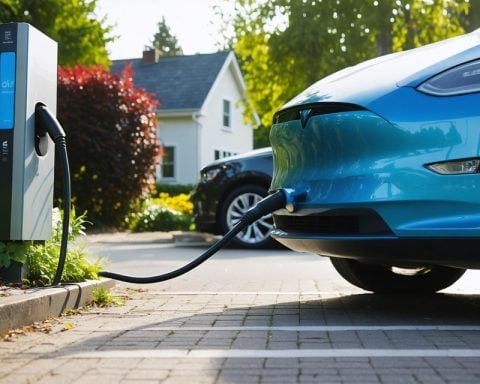- EV battery degradation is manageable, with only a 7% capacity loss observed over seven years for vehicles from 2017.
- EVs purchased from 2019-2020 maintain around 96% of their original battery capacity, while those from 2021-2023 retain 97%.
- The typical EV range reduction is minimal, with a new 180-mile EV seeing about a 167-mile range after seven years.
- Average EV owners drive approximately 6,001 miles annually; less driving may lead to lower battery degradation.
- Cold weather can decrease EV efficiency, potentially cutting range by up to 40%.
- Charging habits and environmental conditions affect battery lifespan, but drastic degradation fears are often exaggerated.
- Potential EV buyers can expect gradual battery decline, with significant performance drops being a distant concern.
The mysteries behind the lifespan of electric vehicle (EV) batteries are unraveling with surprising revelations. Recent insights suggest that while battery degradation is a reality for EV owners, it might not be the looming threat many feared.
Imagine driving an EV purchased as far back as 2017. As the years roll by, what might seem like an inevitable decline barely skims the surface. Owners report a mere 7% drop in battery capacity over seven years, leaving about 93% punch in that powerhouse. Fast-forward to EVs bought as recently as 2019 or 2020, and they maintain an impressive 96% of their initial vigor. Those who hopped on the EV train between 2021 and 2023 need not worry—they enjoy a stellar 97% of original battery life.
Picture this: A new EV boasting a range of 180 miles will stretch its legs to about 167 miles after a seven-year saga. That slight dip may not be the dealbreaker it was once thought to be.
With the average EV owner clocking around 6,001 miles annually, those inclined to drive fewer miles might experience even less battery attrition. However, watch out for Jack Frost—cold weather notoriously saps EV efficiency, potentially slashing range by a staggering 40%.
Various elements, including charging habits and nature’s whims, dance with battery longevity, but the fear of drastic decline might be unfounded. The notorious 30% degradation threshold, where range might severely impact those epic road trips, seems a distant specter for most.
Potential EV buyers, take heart—the decline is gradual, and the first few years promise manageable harmony between expectation and reality. As the electrifying adventure roars on, fears of rapid battery decay might just run out of charge.
Unlocking the Secrets of Electric Vehicle Battery Longevity: What You Need to Know
How-To Steps & Life Hacks
Maximize your EV battery life with these practical steps:
1. Moderate Charging: Avoid charging your battery to 100% or letting it drop to 0%. Instead, keep the charge level between 20% and 80% for optimum health.
2. Use Fast Charging Sparingly: High-speed charging can rapidly increase battery temperature, leading to faster degradation. Reserve fast charging for when it’s truly necessary.
3. Temperature Management: Park in shaded areas during hot weather; in cold climates, maintain a garage to keep your battery consistently temperate.
4. Reduced Fast Acceleration: Aggressive driving can lead to quicker energy consumption and heat, both of which can strain the battery.
5. Software Updates: Keep your EV’s software up-to-date to ensure the battery management system operates with improved efficiency.
Real-World Use Cases
– Urban Commuting: EVs are particularly advantageous for daily urban commuting, where lower speeds and regenerative braking can enhance battery efficiency and maintain longer range per charge.
– Corporate Fleet Operators: Companies transitioning to electric fleets can benefit from the predictable maintenance schedules and reduced fuel costs, paired with extended battery warrantees.
Market Forecasts & Industry Trends
The EV market is expanding at a rapid rate, with projections for a 30% compound annual growth rate (CAGR) through 2030 (Source: McKinsey & Company). Battery technology advancements will further reduce costs, increase energy density, and improve charge times.
Reviews & Comparisons
When evaluating EV options, consider:
– Battery Warranty: Different manufacturers offer varying coverage, often around 8 years or 100,000 miles, whichever comes first.
– Range Variability: Research independent reviews that factor in real-world driving conditions since environmental factors can significantly alter range.
Controversies & Limitations
– Resource Sustainability: Concerns persist around the mining practices for lithium, cobalt, and nickel. Manufacturers like Tesla and Rivian are actively researching recycling methods and sustainable alternatives.
– Cold Weather Issues: Cold climates still pose challenges to range and charging times, but pre-conditioning systems and heat pumps are being designed to mitigate such effects.
Features, Specs & Pricing
– Features: Modern EVs come equipped with cutting-edge technology, including advanced driver assistance systems (ADAS), IoT connectivity, and over-the-air software updates.
– Pricing Trends: Initial costs remain higher than conventional vehicles; however, price parity is expected by the mid-2020s due to reductions in battery costs and increased production volumes.
Security & Sustainability
Cybersecurity protocols are critical for protecting connected vehicle systems; manufacturers implement robust encryption methods in their software architecture. Sustainability efforts include battery recycling initiatives and using eco-friendly materials.
Insights & Predictions
Electric vehicles will continue to rise in popularity, driven by governmental regulations on emissions, technological advancements, and a growing consumer shift towards sustainable transportation.
Tutorials & Compatibility
– Charging Compatibility: Check if your home can support a Level 2 charger installation for faster home charging, and consider a portable Level 1 charger for emergencies.
– DIY Maintenance: Simple tasks like checking tire pressure and cabin air filter replacement can be done independently, enhancing performance and efficiency.
Pros & Cons Overview
Pros:
– Lower running costs and emissions.
– Rapid technological advancements.
– Growing infrastructure for charging.
Cons:
– High initial purchase price.
– Charging time is longer compared to refueling.
– Range limitations in certain weather conditions.
Actionable Recommendations
– Test Drive Multiple Brands: Experience various models to understand range, comfort, and features specific to your needs.
– Plan Home Charging Setup: Ensure your electrical system supports the necessary setup before purchasing an EV.
– Stay Informed: Regularly update yourself on new battery technologies and protective strategies through reputable sources like Tesla or BMW.
By embracing these insights and strategies, you can make informed decisions on adopting electric vehicles while optimizing their lifespan and performance for an electrifying future.













